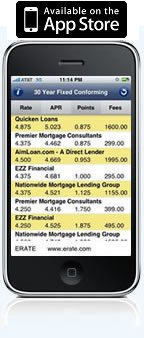The Rise and Fall of Interest Rates: How Interest Rates are Determined
by Amy Lillard
(9/19/2012) Anyone who has ever applied for a home loan, auto loan, or even a credit card, has had to learn quickly about interest rates. But this education often results in more questions than clear answers.
How does interest work? How are rates determined? How does the Federal Reserve, who made news this month with a new plan to improve the economy and reduce rates, play a role? And what does it all mean for finding a good mortgage interest rate?
INTEREST DEFINED
Defining “interest rate” is actually fairly simple. An interest rate is the price of money. Whether it’s charged by the Federal Reserve to banks, by banks to other banks, or by lenders to you for the purchase of homes, cars, and other credit, the interest rate determines how much borrowers have to pay in exchange for borrowing money.
That’s the easy part. The difficulty in understanding interest rates comes when you consider their extremely fluid nature. Rates change constantly, going up and down almost daily due to economic pressures, policies, and market activity. The basic force of supply and demand in our economy, for example, is a big force in interest rates. If a large number of people are seeking home loans from lenders, demand for money is up. To keep supply up, banks need to borrow money from other institutions at a price. They then pass on that price to consumers in the form of higher interest rates. Alternatively, if demand is low, interest rates may be lower as well.
Interest rates also react to human behavior. When investors have confidence or lack of confidence in the U.S. market, or when pundits opine about the direction of rates and the economy at large, rates can be affected.
It’s a heady mix of factors that play into interest rates, and results in a very slippery concept to grasp. And then the Fed comes into play.
ROLE OF THE FED
The Federal Reserve, or the Fed, is a government entity with a heavy purpose: they are in part responsible for maintaining full employment (around 4-5 percent unemployment) while keeping inflation low. While they have multiple methods to employ in order to achieve this delicate balance, their most powerful is influencing interest rates.
The Fed can direct interest rates on credit cards, mortgages, auto loans, small business loans, and all other types of loans by changing the Discount rateor indirectly influencing the Federal Funds rate.
The Discount rate is the interest rate charged to banks when they borrow funds directly from a Federal Reserve Bank. If the Fed increases this rate, banks have to pay more for funds. They then charge more interest to individual and business borrowers seeking funds.
The Federal Funds rate is the rate banks charge to each other. The Fed requires banks to keep a certain percentage of assets in cash on hand, or deposited in a Federal Reserve Bank. If the Fed increases the required ratio of reserves to deposits, more cash must be kept. Banks can turn to other banks for loans to meet this requirement, and rates will rise due to decreased supply. In return, banks will increase their individual prime lending rate (the rate charged to best customers). This reference rate will then impact rates charged for all types of loans.
These two actions by the Fed can directly or indirectly change interest rates. In addition, plans to buy bonds or other initiatives like those announced this month can impact rates as well. Finally, the power of the Fed is such that even statements made by its members could influence interest rates. Even if the Fed leaves rates untouched, their perspectives on the economy and plans for monetary policy can influence investor actions, which in turn can influence economic actions and interest rates.
This is why the meetings of the Fed, called Federal Open Market Committee meetings, are anticipated and scrutinized so deeply. In times of crisis, like the financial implosion in 2008, the Fed can and does play a critical role with its actions concerning interest rates. The record low ratessince 2008 have been a concerted effort by the Fed to keep money circulating and borrowers seeking loans.
MORTGAGE INTEREST RATES
Our discussion thus far has been about overall interest rates. When it comes to mortgage interest rates, all of these points still apply. But there are a few additional factors that can influence their ups and downs.
In general, it’s important to recognize that mortgage interest rates are more susceptible to economic activity than others. This makes sense logically — if a borrower falls upon hard economic times their biggest expense, their home mortgage, will probably be the first to suffer. For that reason, reports like Consumer Price Index, Unemployment, GDP, Consumer Confidence and others can move mortgage rates significantly. And any activities by the Fed like those as described earlier can instantly and dramatically impact mortgage rates.
In addition, the 10-year Treasury bond yield is often said to be the best indicator of mortgage rate activity. Although most mortgages are packaged in 30-year terms, on average they are paid off or refinanced within 10 years. Therefore the 10-year bond is considered on a similar level of risk and term. Generally, if the 10-year bond yield is up, mortgage rates rise.
Mortgage interest rates are also influenced by bonds because the Fed can use monetary stimulus programs including bond purchases to direct mortgage rates, as announced this month. When the Fed buys mortgage bonds and U.S. Treasuries it increases demand for these items, which keeps mortgage rates down. Conversely, if the Fed sells bonds, it sends rates up.
A final force specific to mortgage interest rates is the secondary mortgage market. Fannie Mae and Freddie Mac buy loans from other lenders, holding them in their portfolio or bundling them with other loans into mortgage-backed securities. These are sold to investors and mutual funds, who trade them like bonds. Interest rates in the secondary market move up and down similar to the stock market, and are affected by economic factors like other interest rates.
PREDICTING RATES
Considering the vast array of powerful factors at play when it comes to mortgage interest rates, it’s no wonder that many experts and analysts say it’s impossible to forecast rates accurately.
In a very general sense, borrowers who are looking to get the best rates can remember that all the discussion above can be summarized as such: what’s bad for the economy is good for mortgage rates. Poor economic performance and news of a slowing economy usually means lower (better) mortgage rates, and good news of a growing economy usually translates to higher rates. Of course, this is very highly simplified, and will not apply in all cases.
In the face of such uncertainty, one thing borrowers can do to improve their lot with mortgage rates is focus on what they can control. Banks will give the best interest rates available to those borrowers with higher credit scores and better payment histories. By ensuring your credit is as good as it can be, and by being a safe bet for lenders, you can get the optimal rates in any economic environment.
Other related articles:
Mortgage Rates and the Stock Market: Understanding the Relationship
No-point, no fee loan regulations due in 2013
Comparison shopping is easier, but nearly half of consumers don't
Understanding Mortgages: What is Interest?
Understanding Mortgages: What is a Credit Score?
Should you wait to lock in a mortgage interest rate?
Fannie Mae & Jumbo Mortgage Rates
Just One Click! = Current Rate Chart

Start by selecting your state

Amy Lillard
The ERATE® Resource Guide to No-Closing-Cost Refinancing
Principal Reduction: New Programs, More Controversy
Understanding Mortgages: Mortgage Paperwork
Understanding Mortgages: Types of Mortgages
Understanding Mortgages: How to Get a Mortgage
Understanding Mortgages: Buy or Rent?
Understanding Mortgages: Working with a Real Estate Agent
Understanding Mortgages: Working with a Real Estate Agent
Refinancing: Selecting a Loan

- Mortgage Program Options
- Interest Only Mortgage
- 100% Mortgage Financing - No Down Payment
- Mortgage Rates Comparison
- Search for Mortgage Rates
- No Costs Mortgage Refinancing
- 2% Rule - Refinancing Mortgage
- Yield Spread Premium
- Prepayment Penalty - Mortgage Refinancing
- What is APR and how is it calculated?
- Private Mortgage Insurance - Refinancing
Moving Ahead With Your Refinance
Get the Updated and Improved Mortgage Rates App from ERATE.com
FREE Mortgage Rate WidgetsYour State's Rates or National Rates Get this Widget for any State you want


